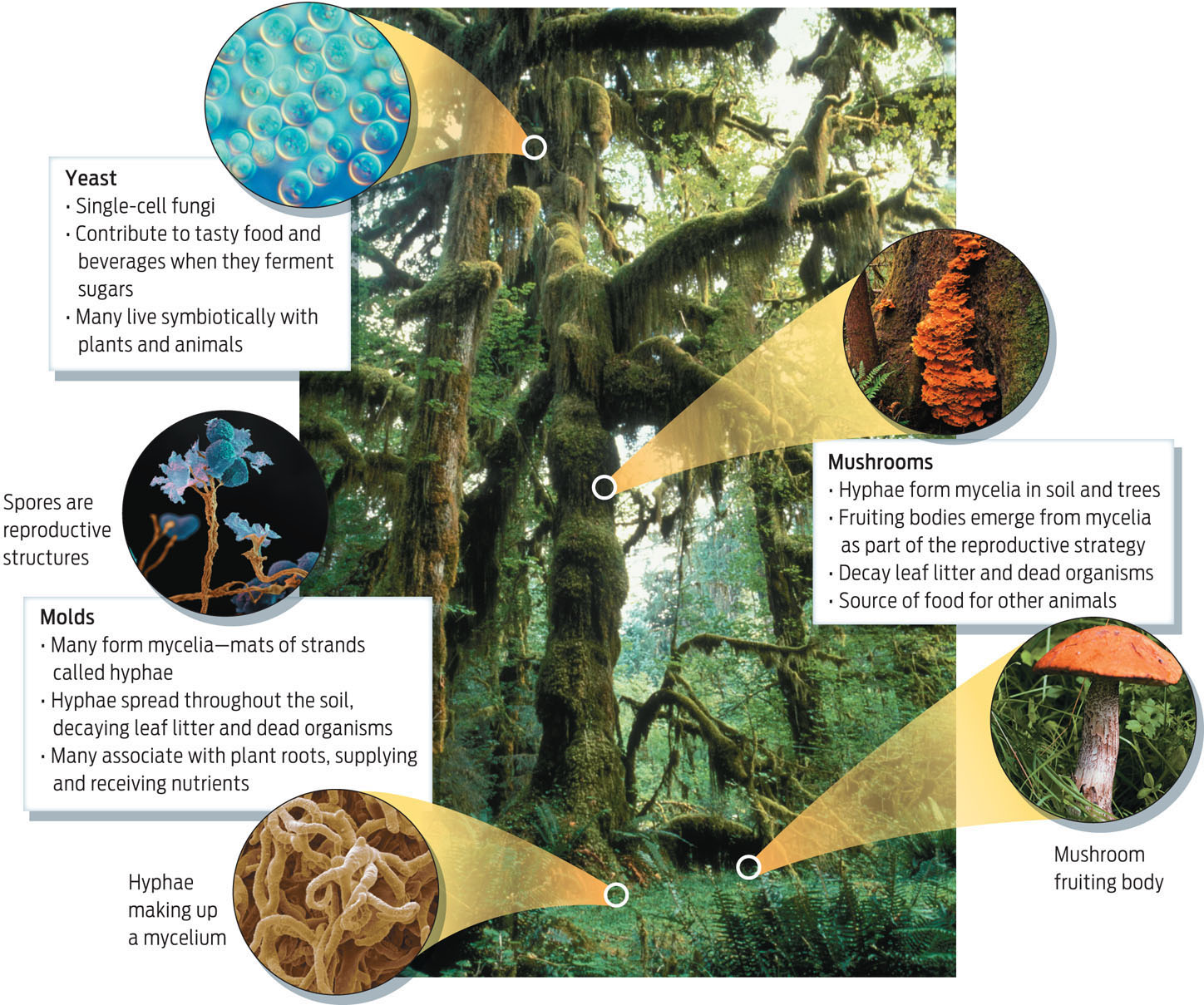Cycles of Life in the Rain Forest
The rain forest is a place of irrepressible life; it is also one of death. Coyotes kill fishers. Fishers hunt squirrels. Insects eat trees. Death casts a long shadow over life in the park, yet without it there would be no life at all.
When organisms are alive, they store nutrients and chemical building blocks in the fabric of their bodies. When the organisms die and decompose, these nutrients and building blocks are returned to the soil and eventually taken up into new life. Crucial to this cycle of life and death, growth and decomposition, are fungi, a third major branch on the eukaryotic tree. It’s impossible to put an exact figure on the number of fungi in the forest, but their role can hardly be overestimated.
DECOMPOSER An organism such as a fungus or bacterium that digests and uses the organic molecules in dead organisms as sources of nutrients and energy.
By breaking down organic matter into smaller particles, fungi help release trapped nutrients. Without fungi, dead trees and animal carcasses would pile up in the forest and smother everything in it. Thanks to the action of fungi, however, the organisms decompose and the elements they contained will nourish many organisms throughout the environment. Many decomposing organisms even provide shelter, such as the tree holes in which fishers and other animals make their dens.
HYPHA (PLURAL: HYPHAE) A long, threadlike structure through which fungi absorb nutrients.
Fungi come in many forms. There are unicellular species, such as molds and yeasts, and multicellular species, such as mushrooms and the shelf fungus you sometimes see growing on a tree trunk. Underlying this physical diversity is a method of obtaining nutrients common to all fungi: they secrete digestive enzymes onto their food source and then absorb the digested products. As one of nature’s decomposers, fungi can break down just about anything that has organic components, including plant parts that are indigestible to many bacterial decomposers. All fungi have cell walls made of chitin (the same molecule that makes up the exoskeleton of the arthropods), and all modern fungi evolved from a common unicellular ancestor—the same one that gave rise to animals—approximately 1 billion years ago.
MYCELIUM (PLURAL MYCELIA) A spreading mass of interwoven hyphae that forms the often subterranean body of multicellular fungi.
Multicellular fungi, such as the mushrooms poking up through leaves in the forest, have a body composed of threadlike structures known as hyphae. Each individual hypha is a chain of many cells, capable of absorbing nutrients. Fungal hyphae interweave to form a spreading mass known as a mycelium. These structures can vary in size and location: the mold on a slice of bread has a small mycelium that’s in plain view. By contrast, the mushrooms you see on the forest floor are merely one aboveground part of what can be a huge, underground fungal mycelium. The largest known organism in the world is a fungus in Oregon with an underground mycelium stretching across nearly 4 square miles.
There are fungi everywhere in Olympic National Park, growing on, in, and under the abundant vegetation. Some species play a critical role in the soil, where they form a symbiotic relationship with the roots of many trees. Their slender hyphae grow into microscopic spaces in the soil where the tree’s roots can’t fit, greatly enhancing a root’s ability to absorb water and nutrients. Trees supply nutrients to the fungi, which do not photosynthesize. Many fungi also live in and on animals, as you probably know if you have ever had athlete’s foot or a yeast infection (INFOGRAPHIC 19.5).
Fungi are a diverse group of organisms with a variety of reproductive strategies. However, all fungi eat in the same way: they secrete digestive enzymes onto their food, then absorb the digested products.

FUNGUS (PLURAL: FUNGI) A unicellular or multicellular eukaryotic organism that obtains nutrients by secreting digestive enzymes onto organic matter and absorbing the digested product.
422